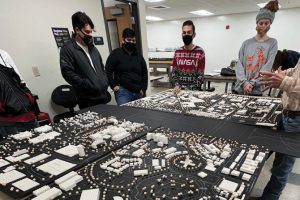This year marks a year of substantial change for our organization. Under the Presidency of Daniel Hart, FAIA, we welcomed Lakisha Ann Woods, CAE, as our new EVP/Chief Executive Officer; the Board of Directors committed funds and a strategy for the successful undertaking of our headquarters’ renovation at 1735 New York Ave; we witnessed our organization’s first presidential race comprised of two substantially qualified and historically underrepresented female candidates; and, with the pandemic beginning to slow, we conducted A’22, our first face-to-face organizational gathering since 2020, in the great city of Chicago and in the company of former U.S. President, Barack Obama.
Through these and many other efforts in recent years, our organization’s work focuses on relevancy both within the profession and the profession itself. During 2020 – as the COVID-19 pandemic was gripping our world – AIA immediately jumped into action by providing services, knowledge, and tools to help members, components, and communities design strategies for reaching the best potential outcomes while considering the impossible situations in which we found ourselves. Special AIA task forces took action to coordinate with public officials on safely adapting existing buildings into health facilities and issuing expert guidance that was distributed by the State Department. In a series of virtual charrettes, AIA convened architects, public health experts, engineers, and facility managers for our Reopening America initiative.
This is an example of the model organization, one that we should always strive to embody. We were relevant at a time of need because we engaged society where and when it needed us most and demonstrated our value instead of just talking about it. When we are relevant, we are valuable, and to me, this is how we flourish; this is how we can simultaneously do the right thing for society and for our practices and professionals.
In connecting the work and direction of AIA National and AIA Northern Nevada, I must borrow a quote used many times this year by President Hart in our work together: Archimedes once said, “Give me a long enough lever and a place to stand, and I will move the earth.” As a smaller chapter, we have our fair share of difficulties and challenges but also our own unique opportunities. I think of our dedicated local volunteer members with their passion and willingness to devote countless hours to something greater than themselves as the solid “place to stand” mentioned by Archimedes. Our “long lever” is something that, due to our size, we find challenges in manifesting. To me, the resources and opportunities provided by AIA National can become this. When our volunteer efforts and national resources mix correctly, we have the power to manage any challenge we face as a local organization.
Northern Nevada’s architectural community has historically struggled to attract young talent into our firms, largely because our region does not possess any professional schools of architecture. High school students in our region who wish to pursue this field must leave for their education. Truckee Meadows Community College (TMCC) and AIA Northern Nevada have long attempted to fill these gaps with a 2-year transferable associate degree as well as robust scholarship programs for financial support. While many have taken advantage of these resources, the consequence of not having a local path to licensure has led to a brain drain phenomenon within the local architectural community since the transfer students most often take advantage of opportunities near their accredited schools upon graduation.
While this circumstance may have fallen on deaf ears only a half dozen years ago at AIA National, our organization is now striving to make the profession a solid place to stand for the current and next generations of architects, especially for women and people of color. NCARB’s latest “By the Numbers” report illustrates the disappointing statistics that highlight the need for nationwide improvement. In Northern Nevada, TMCC provides diverse educational opportunities and has a large population of minority students. As such, we find ourselves in the spotlight with the opportunity to both help our local community and exist as a model for others to cite in the national conversation as well.
AIA National is committed to better introducing the profession to K–12 students by issuing updated lesson guides and other tools for educators, parents, and pupils. Our popular “Build the Block” game for middle and high school students is now web-based and available for chapters’ use in their local K–12 initiatives. At the college level, AIA is beginning to shift the focus away from traditional professional educational models and challenging itself to be innovative in removing barriers to access. We’re focused on strengthening community college pathways and supporting talented students through national scholarship programs that are achieving record levels of support. Nationally, the Diversity Advancement Scholarship, awarded to 12 students entering architecture school, gives students $4,000 per year toward tuition for the next five years, totaling $20,000 each. In financial partnership with AIA National, our local Ric Licata Memorial Scholarship is helping fund two students’ education at TMCC, a model program specifically designed for community college or trade school (two-year) students.
All of this energy surrounding architectural education can locally culminate with the Nevada System of Higher Education’s (NSHE) decision for TMCC to pilot and seek National Architectural Accrediting Board (NAAB) accreditation for a Bachelor of Architecture, the first professional degree of architecture in Northern Nevada. Many hands have come together to achieve this goal, including TMCC faculty, administration, and local AIA and AIAS members. We still have a long way to go, but I’m encouraged that the steps we’re taking now and the resources we have from our national organizations will bear meaningful fruit for our local community in years to come.
Finally, our profession exists as stewards of the built environment. Being an architect today requires a host of skills far beyond the technical proficiency of building science and the graphical clarity of construction documentation. Far beyond what’s commonly defined as “architecture,” society and the profession benefit from architects who engage in the civic realm. When the public, policymakers, legislators, and strategic partners understand the full value of what architects can offer to address the challenges of communities, we all thrive. Our active involvement in big issues matters a great deal!
In early June 2022, AIA was the title sponsor of the U.S. Conference of Mayors’ (USCM) annual conference in Reno, NV. Our own mayor, Hillary Schieve, is the president-elect of the USCM and, as such, hosted 33 other mayors from cities around the country. Among the countless contacts and meetings with AIA National members/staff and their respective city leaders, AIA CEO Lakisha Woods took to the main stage with City of Houston Mayor Sylvester Turner. Together, they urged mayors to utilize architects and AIA as their partners for progress. AIA President Hart moderated a panel discussion on local efforts to improve building energy efficiency and reduce greenhouse gas emissions. When panelist Mayor Andrew Ginther of Columbus, Ohio (now president-elect of the USCM) pointed out how helpful AIA Columbus had been for him in navigating some of the city’s long-term challenges related to zoning and climate, AIA President Hart was quick to remind the audience of mayors that there is an AIA chapter conveniently located near each of them! Civic leaders are hungry for practical advice.
These opportunities connect the local to the national. They enhance our stewardship and voice, helping us eliminate barriers and create a brighter, fairer, and more sustainable future. Most importantly, they build relevance to that of our profession as seen from the outside; from the youth, who are looking into their future and dreaming of architecture as a viable career path, or from our civic leaders working tirelessly to find solutions to ever-changing problems.
While this is powerful, we can’t help unless we’re in the room, at the table, on the front lines, constantly expanding what we do outside our offices’ walls. This is the American Institute of Architects in 2022.









